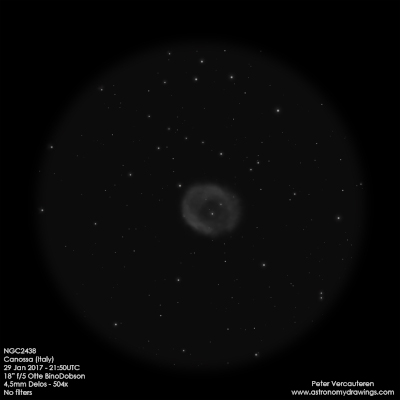
80mm (1/15/07): visible continuously in the finder using an OIII filter and a 13mm Nagler (25x) as a very faint, very small disc on the NE side of M46.
William Herschel discovered NGC 2438 = H IV-39 = h464 = h3093 on 19 Mar 1786 (sweep 540) and recorded "pB, R, resolvable, within the 46th of [Messier], almost of an equal light throughout, about 2' diameter, no connection with the cluster, which is everywhere free from nebulosity." On 8 Mar 1793 (sweep 1034) he noted "A round, pretty well defined nebula; almost of a planetary nebula aspect." From South Africa, John Herschel wrote, "a very fine planetary nebula, oval, uniform in light, and of a very flat appearance; rather faint; diam in RA = 4 seconds; has a star 15th mag on it, and one 13th mag close to its border. This object is excentrically situated in a superb cluster of stars 12..16th mag. (46 Messier)"
Lord Rosse or assistant Johnstone Stoney sketched NGC 2438 as annular on 22 Dec 1848 (figure 12 in the 1850 PT paper). It was observed a total of 21 times at Birr Castle including with a visual spectroscope on 15 Feb 1876. William Lassell also noted the annularity using his 24" equatorial reflector on 11 Jan 1853: "The star is not in the centre, and the nebula seems to retreat from the star, leaving it on a much darker ground than the external parts of the nebula. With slight attention another star is seen; and two or three points or bright spots in the nebula occasionally catch the eye." His sketch was published in his 1854 MRAS paper (figure 5) on observations from Malta. Perhaps following Lassell's lead, Secchi sketched in 1856 the "central star" slightly eccentric, along with a second interior star using the 9.5" refractor in Rome.
Based on Crossley photographs, Curtis (1918) reported "the nebula is a very irregular, broad, patchy ring 68" in diameter. The star at SW lies in a gap in the ring."
This planetary is not physically associated with M46 based on differing radial velocities and the youthful age of cluster and is probably superimposed in foreground). Les Dalrymple states a distance of 4500 l.y. for the cluster and only 3000 l.y for the planetary in a S&T article (Dec 2002).
200/250mm - 8" (1/1/84): slightly darker center, fairly small, round.
300/350mm - 13.1" (1/18/85): star near center very easy and second interior star definite.
13.1" (1/28/84): annular planetary on the NE side of M46! Fairly bright, moderately large, round, 1.0' diameter. A mag 11 star is just off the SE edge and a mag 13 star is just NW of the geometric center (this is not the central star). A third extremely faint star lies on the SW side.
13.1" (11/5/83): clearly annular at 166x.
400/500mm - 17.5" (3/2/02): at 280x this is a beautiful, 1' diameter PN with a darker central hole at 280x situated on the NE side of the rich oc M46. A mag 13 star (not the central star) is within the central hole slightly offset NW of center. The rim is fairly uniform but slightly brighter along the NE side. The 20" central hole is clearly darker although there is not a dramatic contrast. A brighter mag 11 star is just off the SE edge (about 15"-20" SW of the mag 11 star, a faint mag 14-15 star was also intermittently visible) and a string of faint stars oriented WNW-ESE is just over 1' S. M 1-18 is located 22' NNE of NGC 2438.
900/1200mm - 48" (2/20/12): at 488x, much of the same detail described in the 4/15/10 observation was seen, although the ring itself was less structured. Besides the slightly off-center bright star (the ionizing star is a mag 17.5-18 companion) and a mag 14.5 star ~15" SW, a 16th mag star is at the edge of the rim on the SW side. A mag 16 star on the SE side appears just inside the bright ring. Finally another 16th mag star is near the north edge of the annulus, but clearly within the planetary, for a total of 5 interior stars. The outer rim brightens at this point in a 90° arc to the east and is slightly flattened. The challenging Calabash Nebula (protoplanetary) lies 6.5' ENE.
48" (4/15/10): at 700x, NGC 2438 was a beautiful "cheerio" ring with a sharply defined rim of 1.2' diameter and a fairly large, dark central hole of 25-30". The mag 12.8 star in the center was prominent with a second mag 14.5 star ~15" SW of center. A third mag 16 star was just inside the annulus on the SE side, ~20" from center. The rim had a very uneven surface brightness with an impression of some radial streaks and one or two additional faint, embedded stars. The rim was noticeably brighter along the NE quadrant and to a slightly lesser extent along the opposite SW portion of the rim, creating a bipolar appearance. A bright mag 11 star is just off the SE side and the planetary floats in the beautifully rich star field of M46.
Notes by Steve Gottlieb